Discover 11 hidden attractions, cool sights, and unusual things to do in Prescott (United States). Don't miss out on these must-see attractions: Smoki Museum, Watson Lake Park, and Sharlot Hall Museum. Also, be sure to include Goldwater Lake in your itinerary.
Below, you can find the list of the most amazing places you should visit in Prescott (Arizona).
Table of Contents
Smoki Museum

Museum in Prescott, Arizona. The Museum of Indigenous People, formerly known as the Smoki Museum of American Indian Art and Culture, is located in Prescott, Yavapai County, Arizona holds collections of Native American artifacts.[1]
Address: 147 N Arizona Ave, 86304 Prescott
Watson Lake Park
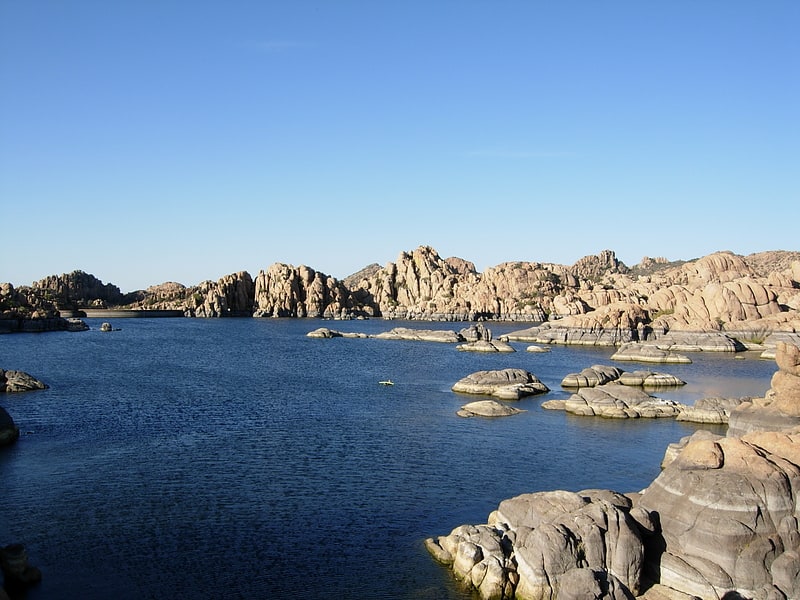
Reservoir in Arizona. Watson Lake is one of two reservoirs at the Granite Dells, in Prescott, Arizona, that was formed in the early 1900s when the Chino Valley Irrigation District built a dam on Granite Creek. The City of Prescott bought the reservoir and surrounding land in 1997 to preserve it as recreational land. Local rockclimbers use the granite cliffs above and adjacent to the lake for top-roping and lead climbing. The lake is also the home of TriCity Prep Rowing Crew, a local high school team and only rowing team in Northern Arizona.[2]
Address: 3101 Watson Lake Drive, 86301 Prescott
Sharlot Hall Museum
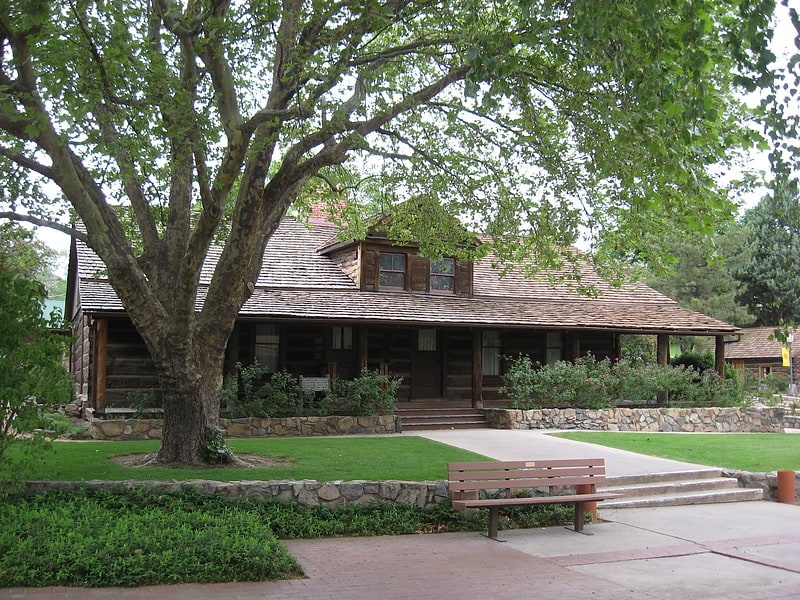
Museum in Prescott, Arizona. The Sharlot Hall Museum is an open-air museum and heritage site located in Prescott, Arizona. Opened in 1928 by Sharlot M. Hall as the Gubernatorial Mansion Museum, the museum that now bears her name is dedicated to preserving the history and culture of the Central Highlands of Arizona.[3]
Address: 415 W Gurley St, 86301 Prescott
Goldwater Lake
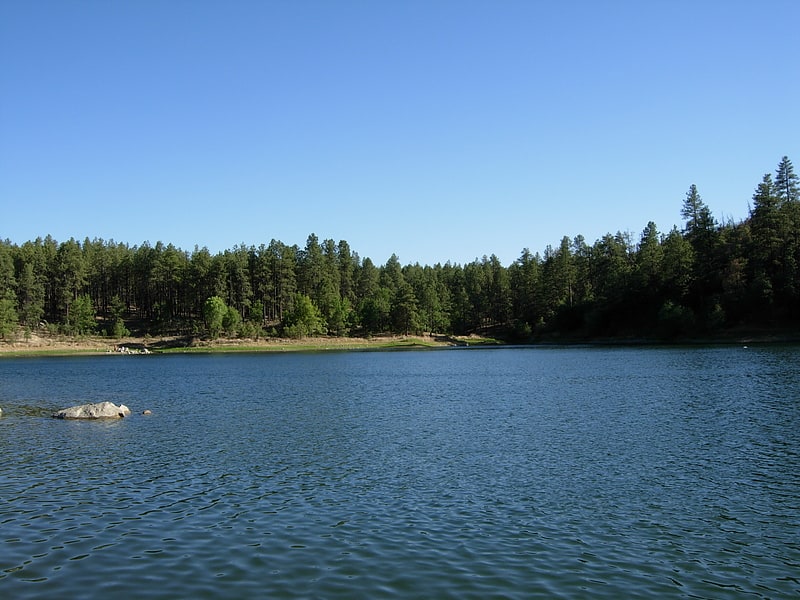
Reservoir in Arizona. Goldwater Lake is a reservoir formed by a dam on Banning Creek, located south of Prescott in North Central Arizona. This lake is maintained by the City of Prescott Parks and Recreation Department. The park has facilities for picnicking, fishing, boating, hiking, volleyball, and horseshoes.
The lake is named for longtime Prescott mayor Morris Goldwater, uncle of U.S. Senator and 1964 Republican Presidential candidate Barry Goldwater.[4]
Address: 2875 S Goldwater Lake Rd, 86303 Prescott
Prescott National Cemetery
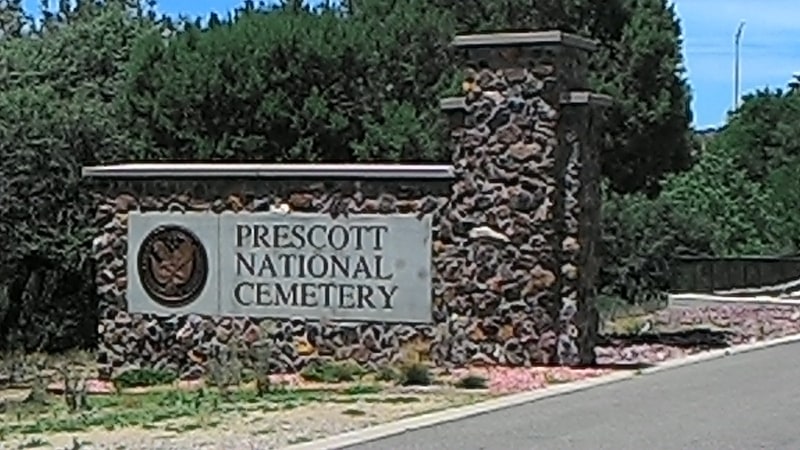
Cemetery. Prescott National Cemetery is a United States National Cemetery located in the city of Prescott, in Yavapai County, Arizona. Administered by the United States Department of Veterans Affairs, it encompasses 15.4 acres, and has over 7,500 interments. Beginning in 2020 its new columbaria is accepting new inurnments. It is one of two national cemeteries in Arizona.[5]
Address: 500 N State Route 89, 86313 Prescott
Elks Building and Theater

Theater in Prescott, Arizona. The Prescott Elks Theater and Performing Arts Center is a classically designed turn of the 20th century opera house seating over 500. Completed in 1905 and listed on the National Register of Historic Places as Elks Building and Theater, it was one of many "Elks' Opera Houses" across the country. Now over a hundred years later only one still exists.
The theater in the beginning was the host to minstrel shows, balls, plays and theater performances. Movies arrived with the silent era about 1915. In 1929 sound was added and the "talkies" had arrived. Movies continued to be shown till the 1980s. After many changes of private ownerships the opera house was turned over to Arizona Community Foundation in the early 1980s. Then began the effort to return the opera house to its original glory. The opera house was purchased by the City of Prescott in 2001. The Foundation in partnership with the City began the restoration with the lobby, green room, dressing rooms and other parts of the building. Restoration was finally completed by the Foundation and the City in 2010.
A $1.75 million renovation of the theatre in the building was completed in 2010.
In 2012 the City sold the buildings to a non profit, The Elks Theater and Performing Arts Center (ETPAC). The theater restoration completed, the ETPAC then began plans to renovate and restore the three-story Elks Lodge #330.
The new restoration project continued through 2016 when in December all construction was completed. Added to the lodge were two state of the art professional dance studios; one with a floating Hickory dance floor and the other with a "sprung Marley" surface. Each studio is self-contained with its own adjustable lighting, heat and air conditioning and state of the art sound systems. Also found on the second floor are five Wenger music and voice isolation practice booths. Plans are in the works to include a digital recording board.
The third floor of the ETPAC sports two separate banquet halls with a total floor capacity of 200 people and a whole floor sound system. A brand new chef's kitchen was also installed on the third floor, with warming ovens, grills, griddles and more.
During the remodel every effort was made to save and restore the original construction where possible. That is why you will find the original barrel ceilings with tin stamp found in other parts of the building still in place. The renovation also uncovered a hidden staircase that was saved along with the original stained glass "clock" that was placed in the building by the Brotherhood of Elks. It points to 11 o'clock when in Elks' traditional a toast is made to absent members."Bill" the original locally sourced copper Elk still lives on the roof of the performing arts center.
The ETPAC is a 501c3 charitable organization. As part of the purchase agreement an endowment was set up for the perpetual operation and maintenance of the theater and performing arts center.
The mission of the ETPAC is to enhance the community of Prescott by providing space for practice, rehearsal and training of the performing arts.
The Elks Theater and Performing Arts Center on East Gurley Street in Prescott, Arizona is a three-story Early Commercial style building built in c.1905. It is approximately 95 feet (29 m) wide and 125 feet (38 m) deep. It was listed on the National Register of Historic Places in 1978.[6]
Address: Prescott, 117 E. Gurley St.
Prescott Center for the Arts
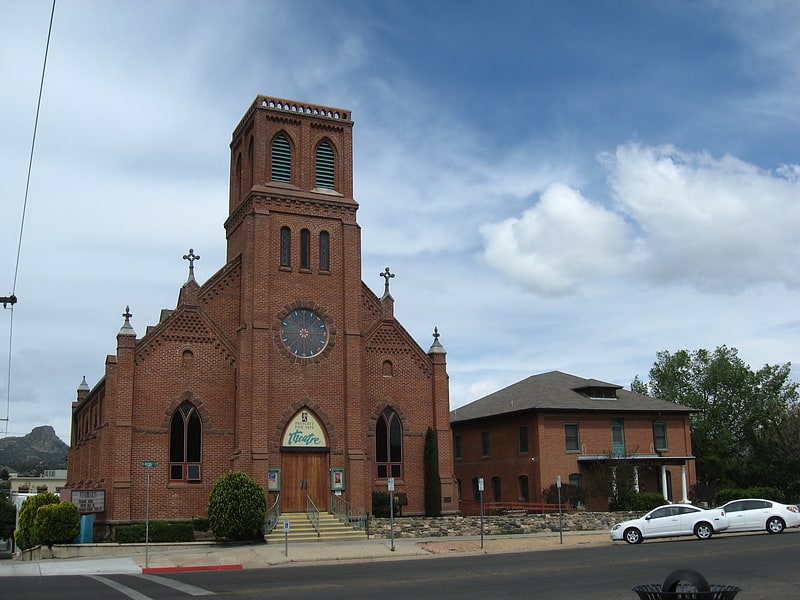
Building in Prescott. The Sacred Heart Catholic Church and Rectory in Prescott, Arizona, United States is a complex of buildings that is listed on the National Register of Historic Places. In 2016, it serves as the Prescott Center for the Arts, formerly the Prescott Fine Arts Association. It is the former home of the Sacred Heart Catholic Church, founded in 1871 now located at 150 Fleury Avenue in Prescott.
The church is asserted to be "one of the best examples of nineteenth century religious architecture in Arizona". It was designed by architect Frank Parker and was built in 1915. It had a steeple until it was destroyed in a storm in 1930. The buildings served the parish until 1969.[7]
Address: 208 N Marina St, 86301-3106 Prescott
Prescott Post Office
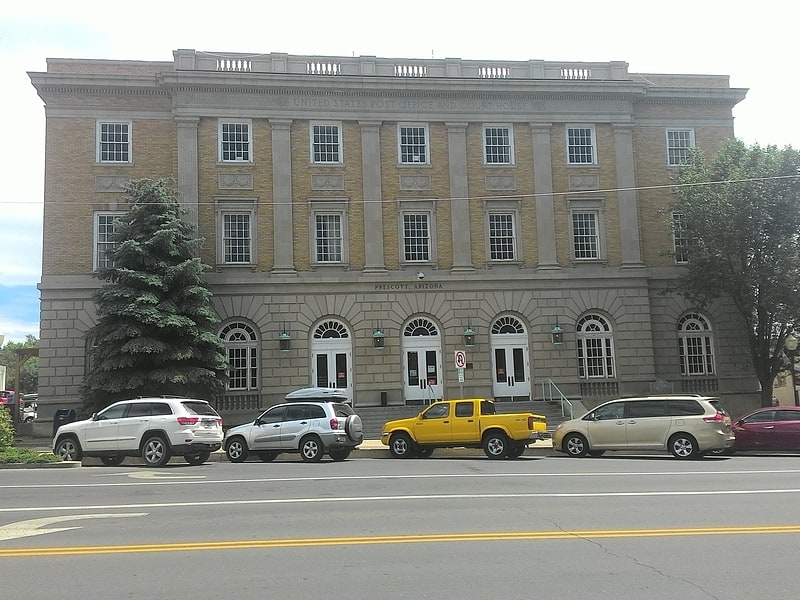
Post office in Prescott, Arizona. The U.S. Post Office and Courthouse–Prescott Main, in Prescott, Arizona, was built in 1931. It was or is also known as Prescott Main Post Office and Courthouse and Prescott Main Post Office. It was listed on the National Register of Historic Places in 1985. It is a Beaux Arts architecture building and is NRHP-listed for its architecture.
The Post Office steps are made of porphyritic granite from Minnesota, containing large 1-inch phenocrysts of orthoclase feldspar. The original plans called for using local Prescott Granodiorite, as at the nearby Courthouse. The post office lobby is clad in fine veined Indiana marble. The side room in the northwest corner of the lobby has noteworthy wavy-texture marble.[8]
Address: 101 West Goodwin Street, Prescott
Fort Whipple

Museum in Prescott, Arizona. Fort Whipple was a United States Army post temporarily established at Del Rio Springs, north of present day Chino Valley, Arizona, by Major Edward Banker Willis and Captain Nathaniel J. Pishon on December 23, 1863. They led Companies C and F of the First California Volunteers and built the post under General Order #27 issued by General James Henry Carleton. The post was named Fort Whipple, after Amiel Weeks Whipple, an American military officer and topographical engineer. He served as a brigadier general in the American Civil War, and was mortally wounded on May 7, 1863 at the Battle of Chancellorsville in Virginia.
The Governor’s Party arrived at Fort Whipple on January 22, 1864. Consisting of most of the officials of the new territorial government of Arizona, Governor John Noble Goodwin used the fort as his headquarters while he visited the territory to determine a permanent location for the fort and territorial capital.
On May 18, 1864, Major Willis relocated the fort twenty-one miles south to a miner's tent settlement on the east bank of Granite Creek. The relocation of the fort was recommended by Governor Goodwin. Its placement was on higher ground, had better access to lumber, and the military could better protect miners. The fort was a large rectangular pine-log stockade. At the same time, Whipple Depot was established as part of the fort. In late May, Prescott (approximately 1½ miles west of the fort) was designated as the capital of the Arizona Territory. In setting up the territorial government, Goodwin's administration oversaw the first election of members to the 1st Arizona Territorial Legislature in July 1864. In September 1864, they met in Prescott and adopted the Howell Code, which was the first set of statutory laws to govern the territory. The legislature also enacted legislation establishing the Arizona Historical Society, creation of mail routes, and establishing a public education system, which included a public university (the University of Arizona). The legislature's meeting in Prescott made it the de facto capital of the territory.
The old site at Del Rio Springs continued to be used by scouting parties and was called Camp Clark, in honor of John A. Clark, Surveyor General of the New Mexico Territory. The camp site was later sold, becoming Postle's Ranch.
Fort Whipple served as a tactical base for detachments of several regiments involved in the American Indian Wars between 1864 and 1886. Fort Whipple became headquarters of the Military Department of Arizona from 1870 to 1886 when Colonel George Crook was assigned to Fort Whipple. He was responsible for having a new fort built to replace the decrepit palisade fort. Between 1869 and 1872, the old fort stockade was razed and the majority of new construction occurred up until 1877.
Whipple Depot was destroyed by fire in April 1872 and rebuilt by July 1872. In 1878, Whipple Depot was renamed Prescott Barracks. In May 1879, under General Orders #53, Prescott Barracks and Fort Whipple were consolidated to become Whipple Barracks.
From May 1885 to July 1886, Fort Whipple was home to Colonel Benjamin H. Grierson and Troop B of the 10th Cavalry Regiment (United States), also known as Buffalo Soldiers. By 1895, the fort was dilapidated and in 1897 was scheduled for deactivation.
In April 1898 when the United States declared war on Spain, the U.S. Army reopened Whipple Barracks as a point of muster for Arizona volunteers. 200 volunteers were recruited and called the “Arizona Cowboy Regiment”. They departed on May 4, 1898 to assemble in San Antonio, Texas. Officially called the 1st U.S. Volunteer Cavalry, they were nicknamed the “Rough Riders” and fought in Cuba.
Whipple Barracks was inactive between 1899 and 1902, and then reactivated in April 1902 to house troops. New barracks, buildings and quarters were constructed between 1903 and 1908. Four companies (about 500 soldiers' total) moved in.
The Prescott and Mount Union Railway operated an electric trolley passenger service between downtown Prescott and Fort Whipple from 1905 to 1912.
Arizona became a state in 1912. Troops stationed at Whipple Barracks were reassigned to other locations, and in 1913 Whipple Barracks was placed in a caretaker/un-garrisoned post status in 1913, and overseen by a small maintenance crew.
In 1918 during World War I, the U.S. Army reactivated Whipple Barracks as U.S. Army General Hospital #20. The hospital was designed to treat soldiers with respiratory illnesses, primarily tuberculosis (TB). Construction of new wards and other auxiliary buildings took place, including buildings for the American Red Cross and Young Men’s Christian Association (YMCA) organizations.
In 1920 the property was loaned to the U.S. Public Health Service (USPHS) and operated under a permit from the War Department. The USPHS operated Whipple Barracks until Executive Order 3669 was signed on April 29, 1922. This executive order transferred the permit and functions of the hospital to the newly established U.S. Veterans Bureau. The hospital designation became Hospital #50, Whipple Barracks, Arizona. The hospital retained its primary function in treating former soldiers with tuberculosis. The facility became one of the most complete sanatoriums for the treatment of tuberculosis in the country.
On July 3, 1930, Public Law Number 536 authorized President Hoover by executive order to consolidate the U.S. Veterans Bureau along with several agencies focused on the treatment of veterans to become the Veterans Administration (VA). March 4, 1931 was the official date transferring the Whipple Barracks title and property from the War Department to the newly-established Veterans Administration.
The main hospital building (Building 107) was constructed between 1938 and 1939, and opened to receive patients in October 1939.
In July 1959, the VA re-designated Whipple VA hospital as a general medical and surgical hospital, in part due to the decline of tuberculosis patient load and increase of medical and surgical load.
On May 17, 1964, The Veterans Administration celebrated the 100-year anniversary of Fort Whipple. Medical Center Director Kenneth.J. O’Brien presided over the ceremony.
In March 1989, the Veterans Administration became a cabinet-agency and was renamed as the United States Department of Veterans Affairs (VA).
During 1995, a reorganization of the entire agency occurred to refocus and address a variety of veteran’s healthcare needs. The VA hospital in Prescott along with the other VA clinics that served the northern Arizona region was officially named the Northern Arizona VA Health Care System (NAVAHCS).
On April 17, 2004, the VA hospital/medical center complex at Prescott, Arizona was renamed the Bob Stump Department of Veterans Affairs Medical Center, after Congressman Stump, Chairman of the House Armed Services Committee.
Significant expansion and construction has occurred throughout the time when the VA acquired Whipple Barracks. Notable buildings include the Community Living Center (Building 148), which was built in two phases, Phase 1 between 1987 and 1989, and Phase 2 between 1995 and 1997; the Domiciliary (Building 151) built between 1988 and 1990; the new Outpatient Mental Health building (Building 161) built between 2014 and 2015; the new Pharmacy/Laboratory building built between 2016 and 2018.
Certified on the National Register of Historic Places in 1999 by the National Park Service, the historic name of Fort Whipple is listed as “Fort Whipple/Department of Veterans Affairs Medical Center Historic District”.[9]
Address: 500 N Hwy 89, Bldg 11, Prescott
Yavapai County Courthouse
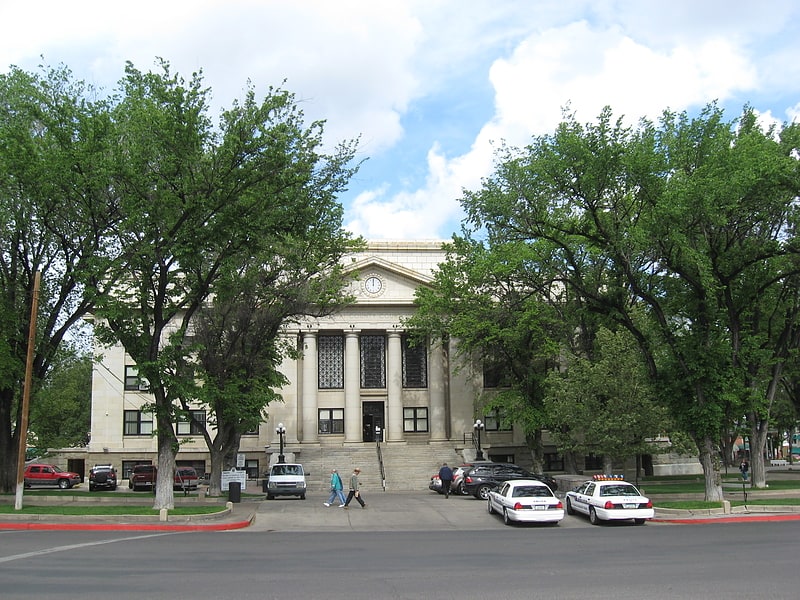
Courthouse. The Yavapai County Courthouse is located at 120 South Cortez Street in Prescott, Arizona. The current courthouse building was built in 1916. It was designed by architect William N. Bowman and it was added to the National Register of Historic Places in 1977. It is also known for its statue of Bucky O'Neill, a Rough Rider and former Mayor of Prescott. Arizona Senator Barry Goldwater announced his presidential candidacy in 1964 from the steps of the courthouse.[10]
Address: 100 E Gurley St, 86301-3821 Prescott
Prescott Public Library
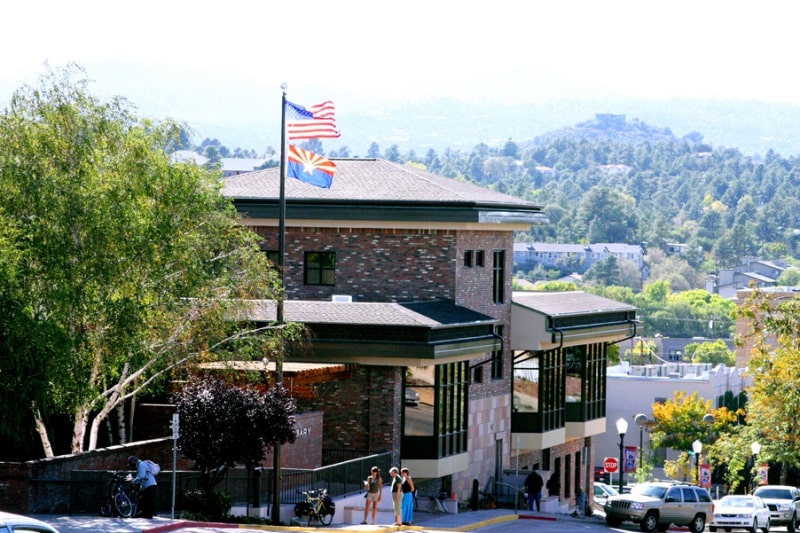
Public library in Prescott, Arizona. The Prescott Public Library is the public library in Prescott, Arizona.
The original Prescott Public Library was a Carnegie library at 125 E. Gurley Street, which is now an office building. It was the first Carnegie library in Arizona. This building was listed on the U.S. National Register of Historic Places in 1975.
The current library location at 215 E. Goodwin Street was built in 1974 and renovated in 2006. The library sees nearly half a million visitors a year.[11]
Address: 215 E Goodwin St, 86303 Prescott